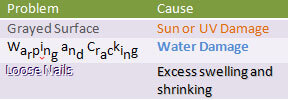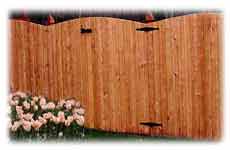Wood Fence Cleaning with a Pressure Washer
 By Victor Hayes Popovics
By Victor Hayes Popovics
Power Equipment Expert
Ultimate Washer Inc.
Last Updated: 2013-01-15
We've all seen it before, sun and rain wreaking havoc on a wood fence until it is soft and grey, and all of the boards and nails are loose. Sun breaks down the surface fibers, causing the wood to weaken and turn gray.1 Rain causes the wood to swell excessively, eventually leading to the breakdown of the internal fibers and the loosening of nails and boards. Fence cleaning with a power washer is the best preventative action you can take against these types of issues.
 * regular pressure washing, staining and sealing can prevent these problems
* regular pressure washing, staining and sealing can prevent these problems
Regular fence cleaning and sealing will keep your fence sturdy, free of algae and mold, and looking good. Keeping a fence clean and sealed will not only save you time and money down the road, but it can also save a few trees. Before you seal a fence, however, it is important to prepare properly with a thorough fence cleaning.
This is important because cleaning a fence prior to sealing it:
- Eliminates dirt, mildew, mold, and algae
- Opens the pores of the wood
- Balances the pores of the wood so that the sealer bonds to each fiber Choosing the right cleaner for fence cleaning is not as easy as you might think.
Cleaners that contain bleach can discolor your fence, cleaners that contain acid can also be harmful to plants, and many Ph neutral cleaners are just plain ineffective. Wood fence cleaning effectively without killing your plants can be achieved by using a cleaner with a biodegradable additive. Environmentally friendly commercial-grade pressure washer cleaners are natural, consumer-friendly and a lot more effective. These products will serve as a cleaner and a brightener. If you are dealing with petroleum or oil on your fence, scrubbing the surface with deck brushes can help remove those tough stains.

- Avoid letting any cleaners, brighteners or strippers, dry on the wood when fence cleaning. This can leave residue and prevent proper adhesion or absorption of sealers. You must rinse it off within 15 minutes!
- Uneven cleaning strokes with power washer extension wands can cause striping where the wand tip was closer to the fence. Striping shows up as an uneven cleaning and can make a fence look unprofessional. Homeowners should practice making nice, even strokes before they undertake wood fence cleaning with a pressure washer.
- As a general rule, previously sealed decks or fences usually need to be stripped before re-sealing.2 This involves using very strong chemical strippers, and is the sort of job best left to an experienced professional. Mold spreads easily and may return if all the mold spores have not been removed or killed.
Fence Cleaning Tips
T |
Use Light Pressure |
Use Large Amounts of Water |
|
Use 1200-1500 PSI for Hard Woods and 500-600 PSI for Soft Woods |
|
Never Use Hot Water as it can Raise the Grain Significantly |
|
Use a Nozzle with a Spray Angle of 25° or Greater (Many Contractors Even Use a 65° Soap Nozzle)* |
Sources:


